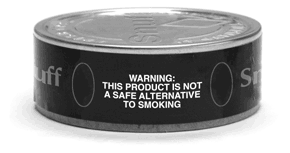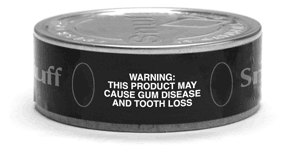


An estimated 9.6 million people in the United States used smokeless tobacco products - moist snuff and chewing tobacco - during 1998, according to the National Household Survey on Drug Abuse. More than 70 percent of these individuals had used smokeless tobacco during the month before they were surveyed.
People who are trying to quit using smokeless tobacco may benefit from a transdermal nicotine patch during the first critical months after stopping use, a NIDA-supported study suggests. Study participants treated with the nicotine patch experienced less severe withdrawal symptoms and lower levels of craving for nicotine and were significantly more likely to maintain short-term abstinence than users in a control group who were treated with an inactive patch. Treatment with nicotine-free mint snuff also reduced withdrawal symptoms and craving but had no effect on abstinence rates.
"These findings suggest that the nicotine patch can reduce the discomfort that people experience when quitting smokeless tobacco," says Dr. Dorothy Hatsukami of the University of Minnesota School of Medicine, who conducted the study. "Knowing that withdrawal symptoms can be minimized may encourage more people to try to quit," she says. While the study suggests that the nicotine patch may help patients achieve initial abstinence from smokeless tobacco, it remains unclear how the patch and other treatments should be used to sustain abstinence over the long term, she says.
Most tobacco-related research has focused on cigarette smoking with its more extensive range of harmful consequences, Dr. Hatsukami says. "However, we also need to study smokeless tobacco use because it is not an insignificant problem by any means," she says. Regular use of smokeless tobacco products may cause such problems as receding gums, tooth decay, mouth sores, precancerous lesions, and cancers of the mouth and throat. Smokeless tobacco users also may be at increased risk of heart disease and smoking cigarettes. Undesirable social consequences include bad breath, tobacco-stained teeth, and the need to spit tobacco juice.
Many individuals use smokeless tobacco despite its obvious drawbacks because they are hooked on nicotine, a highly addictive drug. As with cigarettes, smokeless tobacco products deliver substantial doses of nicotine along with powerful cancer-causing chemicals. Users of moist snuff - which consists of finely ground tobacco - place a pinch, or dip, of snuff between their cheek and gum and hold it there. Users of chewing tobacco - which comes in leaf and plug forms - place a wad, or chew, in their cheek pouch and chew it. Because nicotine from smokeless tobacco is absorbed through the mouth, the drug takes longer to produce its rewarding effect in the brain than it does when it is absorbed through the lungs during cigarette smoking. The amount of nicotine obtained from smokeless tobacco is comparable to that of cigarettes, and once smokeless tobacco users become addicted they find it just as difficult as cigarette smokers do to quit, Dr. Hatsukami says. She notes that more than 90 percent of the smokeless tobacco users in her study had tried unsuccessfully to quit on their own at least once. Nearly 25 percent of the study's participants had made more than 6 unsuccessful quit attempts, and nearly 10 percent had tried to quit more than 10 times.
In her study, Dr. Hatsukami randomly assigned a total of 402 smokeless tobacco users to one of 4 treatments: active nicotine patch, inactive patch, a combination of active patch and a non-nicotine mint snuff, or a combination of inactive patch and mint snuff. All participants received initial counseling on smokeless tobacco cessation methods and a self-help manual to take home prior to beginning treatment. On their quit date, patients began using their assigned treatments and continued for 10 weeks. During treatment, participants met weekly with counselors for brief support sessions. Results were assessed 15, 25, 36, and 62 weeks after participants stopped using smokeless tobacco. The study found that both the active patch and mint snuff reduced craving and withdrawal symptoms, such as irritability, frustration, anger, anxiety, and depressed mood. Withdrawal symptoms generally peaked during the first week after use was stopped. Only the active patch improved rates of continuous abstinence at 10 and 15 weeks following cessation. By the 23rd week, the differences in abstinence rates among all treatments had become marginal, although active patch users were still slightly more likely to be abstinent. At 62 weeks following cessation, no significant differences in abstinence were observed for any of the treatment conditions.
"A number of studies have shown that the nicotine patch is more effective than a placebo patch in sustaining long-term abstinence from cigarette smoking, but the patch appeared to be effective with smokeless tobacco users only during the period of actual patch use and shortly thereafter," notes Dr. Hatsukami. "We don't know if this means we need to use the patch for longer periods of time with smokeless tobacco users or if sensory or behavioral aspects of smokeless tobacco use, such as putting something in one's mouth, may be as important as the nicotine in sustaining use," she says. The fact that a nicotine-free mint snuff also reduced withdrawal symptoms illustrates the potential importance of the sensory aspects of smokeless tobacco in sustaining its use, she says. Previous research does suggest that intensive, multicomponent, behavioral treatment may help smokeless tobacco users to sustain abstinence over the longer term, she says.
"Many questions about smokeless tobacco use and its treatment remain unanswered," Dr. Hatsukami says. "We really need to learn more about all the dimensions of smokeless tobacco use to develop effective treatments that are better tailored to this underserved population," she says.
Sources
- Hatsukami, D.K., et al. Treatment of spit tobacco users with transdermal nicotine system and mint snuff. Journal of Consulting and Clinical Psychology 68(2):241-249, 2000.
- Hatsukami, D.K., and Severson, H. Oral spit tobacco: addiction, prevention and treatment. Nicotine and Tobacco Research 1(1):21-44, 1999.
